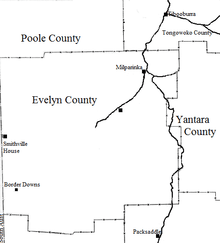King, New South Wales
King Parish, New South Wales is a remote rural locality and civil parish of Evelyn County in far northwest New South Wales,[1] Australia.[2]

The parish is located at 29°47′23″S 142°00′00″E near Tibooburra. The geography of Stewart is mostly the flat, arid landscape of the Channel Country.
History
The parish is on the traditional lands of the Wadigali and Malyangaba people[3] and to a lesser extent Karenggapa,[4] Aboriginal peoples.[5]
April 1529 Spain and Portugal divided the world between themselves with the Treaty of Zaragoza, their dividing line passed through the parish.
Charles Sturt passed by the parish during 1845,[6] and camped at Preservation Creek to the north for six months.
In 1861 the Burke and Wills expedition passed to the east.[7]
Gold was discovered nearby in the Albert Goldfield in 1880.[8] In June 1902 a large meteorite landed at nearby Mt Brown.[9] Temperatures in the area can reach 50 °C.
References
- "Evelyn County". Geographical Names Register (GNR) of NSW. Geographical Names Board of New South Wales.

- Map of Eelyn County.
- Aboriginal Heritage Corner Country History & Heritage Archived 1 March 2018 at the Wayback Machine.
- Tindale, Norman Barnett (1974). "Karenggapa (NSW)". Aboriginal Tribes of Australia: Their Terrain, Environmental Controls, Distribution, Limits, and Proper Names. Australian National University Press. p196.
- David R Horton (creator), Aboriginal Studies Press, AIATSIS, and Auslig/Sinclair, Knight, Merz, 1996.
- "Sturt's Central Australian Expedition". Archived from the original on 1 March 2018. Retrieved 4 March 2018.
- The Burke and Wills Expedition Archived 1 March 2018 at the Wayback Machine.
- THE ALBERT GOLD-FIELDS. The Sydney Morning Herald Mon 18 Aug page 8.
- Ramdohr, P. (1973). The Opaque Minerals in Stony Meteorite.